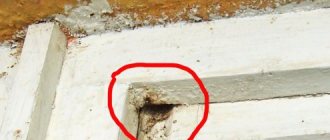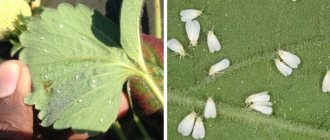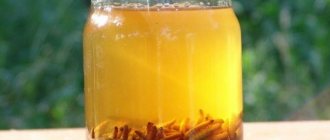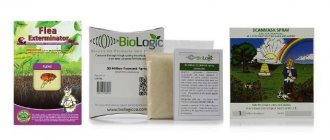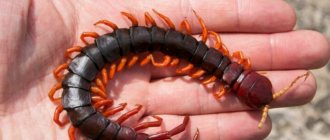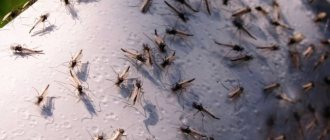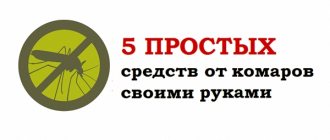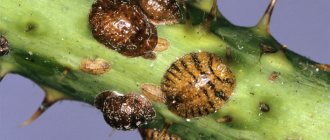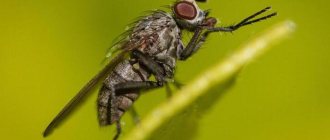The danger of fungus gnats for humans and indoor plants
Sciarids are small insects whose body length is 1.5-4 mm.
The color of adult fungus gnats is black, while the juveniles are gray or light gray. Such pests have translucent wings that are well developed. With their help, the insect moves over considerable distances. Instead of hind wings, sciarids have halteres, presented in the form of a club. Adult insects do not violate the integrity of plants and indoor flowers. They use moist soil in pots and other containers to lay their eggs. The number of eggs in one clutch varies from 290 to 300 pieces. Fungus gnat larvae can be expected to appear within 2–4 days. The larvae resemble worms that do not have legs or wings.
Sciarids never attack adults or children. They don't consume blood. American researchers provided such data. Insects do not react to the proximity of the mucous membrane or the carbon dioxide that a person exhales.
Fungus gnats are dangerous because they transmit certain infectious diseases. This infection affects the condition of people and indoor flowers. A person becomes infected if they come into contact with infected plants. It is difficult to identify such a disease at the initial stage, so the condition of housewives can significantly worsen.
The larvae, which are found in flower soil, feed on the roots and shoots of a variety of plants:
- Hibiscus.
- Orchid.
- Saintpaulia.
- Poinsettia.
- Violet.
To quickly identify the presence of midges, you need to know why they appear. The appearance of sciarids can be caused by:
- Increased level of humidity in the room.
- Caring for flowers and indoor plants is not done correctly.
- Buying orchids, violets or other flowers that are infected with the fungus gnat.
Before getting rid of fungus gnats, it is necessary to study the basic methods and methods of control. Chemicals supplied by popular companies and folk remedies are suitable for these purposes.
Folk remedies
Once the presence of sciarids in potted plants has been established, the humidity level must be reduced. If the number of larvae is large, then a pot with new soil is prepared for the flowers. In this case, you should use an earthen measure.
Among the folk remedies are:
- Treating the soil with pre-dried tobacco. This mixture is administered 4–5 times over 7–8 days.
- The top soil layer is treated with a soap solution. A sprayer is used for this.
- Drainage is introduced into the pot. To prepare it, people use coarse sand or gravel.
- Natural repellents are used to treat vegetation. Experienced gardeners use citrus extracts or anise oil.
- Nepenthes is placed next to infected plants. This plant consumes a variety of insects.
If you have not gotten rid of midges on flowers using folk remedies, the use of chemical compounds is allowed. The rules for their use are described in the instructions supplied by the manufacturers. Among the extensive list are:
- Reid and Neo. Such compositions get rid of midges and flying pests.
- Aktara, Inta-vir and Karbofos. They are prepared in accordance with the recommendations. The resulting solution is used for soil treatment.
- Insecticidal preparations.
You can quickly get rid of fungus gnats if you use proven insecticidal preparations, repellents and folk remedies. Read the instructions before using them. After all, even minor mistakes can cause the death of vegetation.
Sciara fly, order Diptera, family Sciaridae (sciarids) is a small black-gray mosquito about 1.5 mm long with a narrow body and a rounded head. The insect has only a front pair of transparent wings; the hind wings are transformed into club-shaped halteres. Mouthparts are sucking. They fly well and, in suitable conditions, easily reproduce in large numbers.
| Fungus gnat | A clutch of fungus gnat eggs in a flower pot. | Fungus gnat larvae damage the roots, causing rot. |
Adults do not harm plants, but lay small eggs on the surface of moist soil. Larvae later appear from the eggs - translucent, legless worms with a black “head” measuring 8-10 mm. The mouthparts are gnawing. Typically, the larvae develop in the soil on rotting plant tissue.
What is important to know about fungus gnats in order to successfully fight them?
There is no need to panic if large numbers of flying flies suddenly appear at home. First, you should try to figure out who they are and where they came from, and depending on the result obtained, choose a method of getting rid of them.
Do not confuse them with the fruit fly Drosophila! First, look at the flying specimens and make sure that they are sciarids. Mosquitoes, compared to Drosophila, are graceful and slender. The head and chest are larger than the body, the abdomen is thin, about 0.5 mm. Drosophila is a fly, albeit a small one. The abdomen has the proportions of a fly, thicker, without a sharp difference between it and the chest. It appears more often on spoiled fruits, hence the name.
Now, after digging up the soil a little, see if there are sciarid larvae there. If not, then everything is great: it is enough to destroy only the flying mosquitoes, which is not so difficult.
We suggest you read: Flea collar for cats: anti-flea collar for ticks, which one is better, how it works, instructions, good for a kitten
If you do find thin white larval worms with a black head and a segmented body, then this too can be solved. It should be taken into account that worms can also be soil nematodes or young earthworms. At high magnification, it is clear that the body of nematodes is unsegmented, and the head is not prominent in both nematodes and earthworms.
This is what a fungus gnat looks like
- fungus gnats;
- gall midges;
- woodlice;
- ticks.
The first place is occupied by small midges. There are two types of them - gall midges and mosquitoes. Since they feed on soft plant tissue, they can cause considerable harm, especially to young mushrooms.
Outwardly, these two pests are similar to each other. Flower growers have undoubtedly encountered small midges on flowers that quickly multiply throughout the apartment. Favorable conditions for them are high humidity, the presence of soil, and the smell of rotting plant remains.
How dangerous are sciarids for indoor plants and seedlings?
First of all, fungus gnats are the worst enemies of mushroom growers, because by attacking the fleshy parts of the stems and caps, they turn the mushrooms into a spongy mass.
In plant production, female sciarids lay eggs near plant roots. An adult female can lay about three hundred eggs during its short life (they typically only live for about a week). Within 4-6 days, the eggs hatch into voracious larvae, which begin to eat the root tissue, disrupting its absorption capacity.
Fungus gnat.
This leads to yellowing of the leaves, stunting of growth, rapid wilting and, subsequently, the death of the plant. In addition, the attacked plant is exposed to various infections and fungal diseases. The younger the plant, the more damage will occur (especially if it grows in a humid environment). Also, the larvae can begin to eat the young foliage of the seedlings, destroying the seedlings completely. This happens when there is not enough organic material in the soil.
Adult midges do not feed on plants, but they can carry diseases, primarily fungal ones. This is because they can easily collect spores from infected plants or soil and spread leaf spots, mold, rot and more.
Characteristics of an insect
Sciarids are small insects that belong to the order Diptera. They arose several centuries ago and were studied by scientists for a long time.
More than 2 thousand varieties are described in scientific books. Some have not been studied by specialists, so detailed information is not available.
Adults are small flies, their body length is 4 mm. They have a dark gray or black tint.
Juveniles are mosquitoes, 2 mm in size. They reproduce by larvae, the peak occurs in the cold season.
Watering plants and flowers becomes less intense, and the soil dries out slowly. The acidity level in the soil increases, so insects begin to actively reproduce.
Note! It is not midges that cause damage to plants, but larvae.
They feed on roots and suppress the plant's strength. Gradually it withers and rots.
Description and appearance
Experts identify about 1.5 thousand species of this insect. But gardeners at home most often encounter only one of them, namely sciaridae .
Fungus gnat
The size of an adult insect is 3-4 mm. The fungus gnat has a narrow, elongated body and a rounded head. The color of the insect is gray or black. In the thoracic region there are three pairs of thin paws. In the frontal part there are elongated whiskers that help the insect navigate in space. The fungus gnat has one pair of transparent wings. Adults do not feed; their main function is to breed offspring.
Fungus gnat
Sciarid larvae
The larvae of the fungus gnat are worm-shaped and legless. Their body length at birth does not exceed 2 mm, and during development it reaches 10 mm. The larvae have a dark head and a transparent light body color, through which the intestines are visible. The mouthparts are gnawing type. Large larvae are capable of leaving a slimy trail on the soil surface as they move.
Sciarid larva
Folk remedies
An unconventional method that is used to get rid of fungus gnats is to buy a nepenthes plant.
It feeds only on insects and attracts them with its own aroma. The plant is sold in specialized flower shops. The only drawback is difficulty in care.
Important! Nepenthes often dies at home.
You can put fresh citrus peels, garlic cloves, lavender branches, and fresh dill on the soil.
The surface of the pots is treated with anise oil. They need to be updated as needed.
This is an effective method that helps get rid of a small number of insects that have entered the house. If they managed to lay larvae, then citrus peels and lavender will not help.
Infusion of tobacco and shag are additional means that are often used to combat fungus gnats. Take 40 grams of dry tobacco and infuse it in a liter of water for 3 days.
The infusion is filtered and additionally diluted with two liters of water. The liquid is used for spraying indoor flowers.
During the day you need to carry out the treatment up to 5 times, then take a break for 5 days.
Soap solution is a simple and affordable remedy. You need to take 30 grams of fine soap shavings and dissolve them in a liter of water.
During the day, 5 treatments are carried out, with a break of 6 days. To destroy larvae in the soil, use a light solution of potassium permanganate.
Spray the soil with it 2-3 times and do not water the soil for 5 days until it dries out.
Useful video
Garlic can be used as a midge repellent
The moist soil in the mycelium is a wonderful place for the midge family. They try to lay larvae in the top layer of mycelium compost. The death of the larvae will inevitably occur if such places are thoroughly dried and watering is stopped for a while. True, you need to prepare for the fact that part of the mycelium will also die.
Mosquitoes try to fly near light sources. You can try to catch them with a vacuum cleaner. Of course, some of the midges will hide safely, but a significant number will fall into the trap. After this, shake them out of the garbage disposal into a bag and throw them away immediately.
Sticky tape fly traps can also significantly reduce the number of flying pests. Having hung it near the mycelium, all that remains is to observe the trap and change it as necessary.
Orange peel can also be used to repel midges
Mosquitoes do not like strong smells. A few cloves of garlic or orange peels placed on the surface of the mycelium will drive away the midges for a while.
A concentrated infusion of tobacco will help get rid of midges in the mycelium. Infuse a glass of crushed leaves in three liters of water for two days, then generously water the soil. This method will not harm the mushrooms, so it can also be used as a preventative measure.
Fighting flies when growing oyster mushrooms
Mosquitoes are afraid of the smell of laundry soap. By dissolving the block in a bucket of water and generously spraying the room, you can quickly get rid of the flying scourge. It is not necessary to water the soil, but if there are larvae in it, you can treat it with a weaker solution.
We suggest you read: How to fight the Prussians
How to deal with fungus gnats
After I encountered a real invasion of sciarids during the seedling season, which seriously ate the foliage of young petunias, and some of the plants simply did not sprout because the germinating seeds were damaged in the ground, I began to monitor fungus gnats very closely. In particular, I have now made it a rule to water all indoor flowers with a strong Aktara solution before the seedling season. Since sciarids cannot seriously harm adult plants, their presence may not be noticed. However, with the appearance of seedlings, fungus gnats will happily attack it, and this is where problems begin.
Also, “Aktara” can be used to spill all the boxes with seedlings if sciarids are circling above them. But when fungus gnats infested only one small container of seedlings, I removed the larvae by hand. For this I used a regular toothpick. This is not a very simple matter, since the body of the larvae is completely transparent and the heads are black. Small worms simply blend into the ground, especially since they are small in size. But if you look closely, you can see that the larvae have a glossy sheen that gives them away.
Once I locate the sciarids, I simply crush them with the sharp end of a toothpick, pressing them into the ground or pressing them against the edge of the container. Some of the larvae may be in the ground, so it usually takes a couple of days to gradually mechanically destroy all the larvae. Adult insects that usually hit glass can be crushed literally with bare hands.
Sciarides cannot seriously harm adult plants, so their presence may not be noticed.
Recently I also learned about diatomaceous earth (diatomaceous earth) as an effective means of controlling various pests. And I assume that if you sprinkle diatomaceous earth powder on the surface of the soil in seedling boxes and flower pots, the larvae will die very quickly, because they have a delicate gelatinous body, and the particles of diatomaceous earth have sharp edges. Such mulch will also discourage females from laying eggs in the soil. But so far, fortunately, I have not had the opportunity to try this method.
Wrestling rules
| Fighting methods | Detailed description |
| Location determination | To get rid of the fungus gnat, you need to determine its habitat and method of penetration. They often occur in areas where food remains remain. |
| Checking the hood, grates that lead to the basement | A mesh with small cells must be installed on the grilles. |
| Soil inspection | There should be no larval eggs in it. Additionally, the root part of the flowers is checked. If damaged, replace the substrate |
| Air check | In the room with flowerpots, good air circulation is ensured to prevent the entry of fungus gnats |
Chemicals to combat flying insects
Flying fungus gnats in flowers can be removed in the following ways:
- Chemical aerosols, which were discussed a little higher.
- Hang fly tape (you can replace it with tape).
- Use a cockroach repellent (such as Mashenka pencil). It is applied to the top of the pot. The second option is to crumble the pencil and sprinkle it around.
Fighting with chemicals
Treatment with insecticides is the most effective method in the fight against midges. It is recommended to resort to this method as a last resort. If there are a lot of pests, it is better to destroy the block; chemicals may not be able to cope with so many, and if you take strong drugs, some of the poison will remain in the mushrooms.
Atellik drug against midges on your plants
Also, the action of insecticides can have a detrimental effect not only on midges, but also on the mycelium. The growth of the mycelium will slow down significantly, which will certainly affect the condition of the mushrooms themselves.
Be that as it may, many owners of mushroom shops resort to the help of chemicals. Treatment must be carried out indoors, using personal protective equipment - a mask, gloves, thick clothing that covers the entire body.
To destroy midges in myceliums, the following drugs are used:
- Aktara;
- Fitoverm;
- Atellik;
- Agravertine.
When preparing solutions, follow the instructions for the drug. A large concentration can have a detrimental effect on the mycelium - the entire crop will die along with the pests. You should treat not only the mycelium, but also all the secluded corners in which insects love to hide. You need to spray the ventilation openings especially carefully, as midges tend to accumulate there.
Eco-friendly ways to control fungus gnats
Of course, sciarids can be easily defeated if you purchase preparations for controlling soil pests at garden stores. However, there are ways to defeat fungus gnats without chemicals.
The best solution is the famous neem oil, which can be called a true natural repellent. The very strong smell of this oil will drive away adults and prevent them from laying eggs in the ground. If the eggs have already been laid, the use of neem oil will render them unviable.
Neem oil can be used for this purpose in two ways:
- Dilute the oil in water for irrigation.
- Spray the leaves and stems with oil dissolved in water.
To prepare the solution, dilute 1-3 ml of neem oil in 1 liter of water and stir for a long time until the oil is completely dissolved. Treatments must be repeated twice a week until you are sure that you have received results. Midges are also repelled by the smell of cloves, geranium and garlic.
Another method is an alcohol-based solution. 250 ml of alcohol is mixed with 1 liter of water, the solution is used to spray plants. Before using, test the product on a leaf and wait a few days to make sure the product is not too concentrated. If the leaf is not scorched, carefully spray the leaves on both sides and place a bowl of solution next to the pots.
A biodegradable, organic, lemon-scented dish soap will also help. Concentration - 40 ml of detergent per 4 liters of water. Gently spray the mixture and wait one hour. After this time, spray the plant with clean water to rinse the leaves and stems.
Hydrogen peroxide can be used for irrigation. A hydrogen peroxide solution kills fungus gnat larvae on contact with the body. One tablespoon of 3% peroxide must be diluted in 500 ml of irrigation water. Mix one part peroxide with four parts water and pour it through the soil into the root zone until it begins to flow out of the drainage hole.
Sprays containing pyrethrin (a substance derived from the pyrethrum plant) are also effective against fungus gnats and their larvae. To use pyrethrins, lightly mist all plant surfaces and topsoil. Ready-made sprays can be purchased at garden stores.
To use pyrethrins, lightly mist all plant surfaces and topsoil.
As a precaution, treat affected and nearby plants with fungicides a day or two after applying pesticides. This ensures that if your plants have been exposed to potentially dangerous disease spores, they will not become infected.
It is worth noting that soaking the roots (watering) is more effective in combating fungus gnats than spraying the foliage of the plant, since the larvae are concentrated and cause harm in the soil.
Chemical methods of disposal
In rooms where there are insects, chemical treatment is carried out using aerosols. They are sold in household chemical stores.
Effective means are Raptor and Raid. Before starting treatment, it is important to remove food products and protect animals from contact with the aerosol.
Important! If there is an aquarium, it is covered so that volatile particles of chemicals do not get inside.
The aerosol is used to treat indoor air, window sills, window frames, and shelving. After 4-5 hours, all surfaces are thoroughly washed with soapy water and clean water.
Other effective chemicals:
- Fitoverm, Actellik, Kinmiks. The solution is diluted according to the instructions. The soil is watered 2-3 times a day, once a week. After treatment, the soil is not moistened for 4 days. Otherwise, the effect of the chemical used is weakened and its concentration in the ground decreases. The treatment is carried out to get rid of the larvae that have appeared in the earthen coma.
- Bazudin. These are granules that are poured into the ground where the larvae are. First remove 2 cm of soil. Next, add granules and clean, uncontaminated soil on top. If the infection is minor, it is allowed not to remove the soil, but simply sprinkle granules on the surface. During watering, they dissolve and destroy the larvae.
- Neo-dichlorvos. When there are a lot of insects flying in the room, they are collected with a vacuum cleaner and sprayed into the air.
- Sticky traps. They trap insects. It is recommended to install them next to flowerpots.
- Chalk "Mashenka". It must first be crushed to a powder state. Draw stripes with crayons on the surface of the pot.
Note! When using chemicals, it is necessary to ensure personal safety.
When working with aerosols, you need to wear goggles, rubber gloves, a gown and a respirator. After treatment you need to take a shower.
5 hours after spraying, the room is ventilated. During treatment, animals and small children must be removed from the house or apartment.
Preventing the appearance of flies
Before planting, the soil is disinfected - heated in the oven or microwave, exposed to frost, treated with steam, or spilled with potassium permanganate.
Any container for flowers must have drainage, and there must be holes in the bottom to drain excess liquid. Watering in the cool season is optimized: the soil should be dry on top, but moist at a depth of 1 cm. It is better to water not from above, but from the pan. You need to water with water that has stood for 24 hours, not forgetting to loosen the top layer of soil afterwards. Loosening is a necessary operation when caring for indoor plants. This is the only way to provide the roots with oxygen, eliminating the process of decay. To dry the soil in a pot, pour a little sand on top, after calcining it.
An interesting way of prevention is to grow onions next to indoor flowers. Having “settled” on the windowsill, it will not only protect the owners from colds, but will repel many pests from their green pets: midges, spider mites, scale insects, thrips and other “invaders”.
Cleaning the room after treatment
What does a mushroom consist of?
It is better to clean the room where the mycelium is located the next day. The first step is thorough ventilation. Hands must be protected with rubber gloves. It’s better to go out while airing out.
The next step is washing all surfaces. You can add a cleaning agent to the water, this will speed up the process and will perfectly wash off any remaining chemicals. The addition of chlorine is also recommended. You need to wash not only the floors, but also the walls and windows. Pay special attention to the part of the room in which the mycelium is located.
After thorough cleaning, begin inspecting the soil and mushrooms. It is better to remove the top layer of compost and replace it with fresh one. This will remove the pest larvae. In flowers it is easier to do this by changing the entire soil; in the case of mushrooms, you will have to be content with a partial replacement.
Preventive actions
It is much more difficult to combat emerging flower pests than to prevent their development. Therefore, it is recommended to pay special attention to preventive measures. They are primarily associated with the elimination of conditions favorable for mosquitoes to live. More precisely, we can highlight the following measures necessary to prevent the occurrence of pests:
- Do not water the plants too much to prevent flooding.
- The water in the trays of the pots should not stagnate.
- When planting plants, use only high quality soil.
- Do not leave “food” for the fly on the plants: dry or damaged leaves, rotten roots, dry inflorescences.
- Grow onions next to flowers, which repel many pests.
Preventive measures
The most important thing in preventing the appearance of insects is to block their access from the outside. To do this, there must certainly be a dense, dense mesh on the ventilation openings. It needs to be replaced with a new one several times a year. You can periodically apply products with an unpleasant odor to the mesh, which insects do not like. If possible, rub it with any pest repellent chalk.
We suggest you read: How to fight subcutaneous mites
Cleanliness of the room and timely cleaning of rotting parts of the mycelium will also help prevent the appearance of insects - mosquitoes will not appear in a sterile environment. Wash all surfaces weekly with lime chloride.
Potassium permanganate solution
Water the compost several times a month with a solution of potassium permanganate. A concentrated mixture is not needed, a slightly pink tint is enough. This will not affect the future harvest, but will effectively protect against uninvited guests.
Regularly replace the topsoil with fresh soil. Compost must be sterilized before use. Also purchase only high-quality soil in specialized stores. Buy mycelium from trusted sellers.
You can get rid of small flying pests in the mycelium, but only by getting to work immediately after detecting them. The effect will increase if the treatment is carried out comprehensively. But it’s even better to prevent insects from appearing by carrying out preventive work.
Timely prevention of the appearance of fungus gnats is the best pest control. The first thing you can do is change the water regime of irrigation and change the watering schedule. In this case, it is best to sharply reduce watering. Remember that the fungus gnat reproduces best in moist soil, and therefore the best control measure is to let the soil in the pots dry out.
To grow indoor plants, you should use only clean substrate that is not contaminated with larvae. Buy packaged soil in specialized stores, and if you prepare the soil for your plants yourself, then you need to be able to process it correctly. To cultivate the land for planting, first it should be well moistened, allowed to drain, and then placed in the freezer to freeze.
Reasons for the appearance of fungus gnats in an apartment
Fungus gnat in the house
To get rid of gnats in indoor plants, it is necessary to establish the reason for their appearance in the room. The most common factors for the existence of fungus gnats in an apartment are:
- increased humidity in the apartment and improper care of house plants;
- purchasing a flower infected with sciarid larvae or adults from a specialized store;
- sciarid can enter the apartment through ventilation ducts, an open window or door;
- a warm and humid environment is an ideal condition for insect life. Having settled in such a room, they lay eggs in the flower substrate and continue to exist.
Having established how the sciarid flower flies ended up in the apartment, it is necessary to begin comprehensive measures to destroy the pests.
Reasons for the appearance of midges on indoor plants
As a rule, midges come to the grower with soil contaminated with their larvae, from which, under favorable conditions, adult flying insects hatch.
It is important to check the quality and carry out preventative treatment of the soil in which you plant the plant, but the presence of flying midges may not be related to your actions. Often midges are a signal of an unfavorable environmental situation in the house
They did not necessarily come from the pot of a plant standing on the window. Like most insects, midges fly to the light, that is, to the window, next to which they enjoy sitting and flying, but they could have flown in from outside
Often midges are a signal of an unfavorable environmental situation in the house. They did not necessarily come from the pot of a plant standing on the window. Like most insects, midges fly to the light, that is, to the window, next to which they enjoy sitting and flying, but they could have flown in from the outside.
These insects love a warm and humid atmosphere, so they live with great pleasure in damp basements of residential buildings and can visit through hoods, pipes and ventilation shafts, especially in the toilet. Having flown into a gardener’s apartment, midges may well take root, laying eggs on the surface of the soil of a recently watered plant and infecting it with their larvae.
Sciarids can also covet food waste (spoiled fruits, vegetables) in the trash can, and linger in the winter vegetable reserves (potatoes, onions). If you are “lucky”, they can find a home in a completely unexpected place, if your apple has rolled somewhere and remained unnoticed, for example, an apple (or its core, which is even worse). Here, treating your flowers with chemicals will not help; you must find and, if possible, eliminate the source.
Violets on the windowsill | Sciarids or fungus gnats
Uzambara violet. Family Gesneriaceae - Gesneriaceae.
Genus Saintpaulia hybrida - Hybrid Saintpaulia.
Sciarides, or fungus gnats.
Sciarids (Mycetophilidae). Every violet lover is familiar with these insects. Everyone knows the little flies that hover over potted plants. Sometimes there are almost none, sometimes there are hundreds. They look like ordinary midges, small in size, black in color, flying around plants. They have long thin legs and mustaches.
These adult dipterans do no harm (they themselves damage anything), but their larvae, which live in the soil, contribute to the rapid destruction of the substrate, can damage the roots, and compact the soil, so the access of air to the roots is sharply reduced.
An adult female lays from 100 to 300 eggs in a pot of soil; after 4-6 days (depending on the temperature), larvae 3-4 mm long emerge from them. The larvae resemble small worms with a translucent body through which the intestines can be seen.
Their characteristic feature is a black head. They grow, they need food to grow, and they feed on various organic matter that is present in a given bowl with a plant. As a rule, these are the roots of the plant itself.
The entire life cycle of one fungus gnat takes 3-4 weeks.
However, when sciarids multiply en masse, they begin to actively feed on living plant tissues, damaging thin roots and harming the overall health and immunity of the plant, which allows them to be classified as pests. This will especially affect young, newly transplanted, fragile rosettes and children.
It should be noted that they absolutely cannot tolerate complete drying out of the soil. Larvae removed from a moist substrate die within a few minutes.
It is almost impossible to get rid of fungus gnats once and for all.
If conditions exist for their feeding and reproduction, they will come to you again as soon as the chemicals expire.
Overmoistening of the substrate and a high content of quickly decomposing organic matter in it are the main conditions under which sciarids feel most comfortable and begin to multiply quickly.
The appearance of a large number of these insects primarily indicates systematic waterlogging of the half-rotted substrate.
There are dying remains - the midges have a happy family life, a lot of work and food for their children. There are no leftovers - they fly off to settle somewhere else.
Midges, also known as sciarids, are a very valuable diagnostic factor in our agricultural technology. During the time that the violet stood without watering, its roots dried out. After watering, the vessels of the roots are no longer restored, but die, and what happens to them in nature is that they must turn into soil, like any dead organic matter. Conscientious sciarids responsibly begin their duties.
Midges are not the cause of trouble. They are a consequence. Living roots do not suffer from their larvae, but in order for them to start feeding on young roots, you need to dilute a large number of them.
Midges indicate that in your collection there are pots with roots that have rotted due to improper watering; this is an indicator of the presence of dried and then flooded roots.
For normal development of larvae from eggs, a moist, warm environment and an abundance of organic matter are needed.
However, if the number of insects has become simply catastrophic, you can water the soil with Aktara.
Remove the top layer of soil 3-4 centimeters and pour a new layer, on top of which you can scatter the insecticides Grom-2, Pochin and mix with the top layer of soil. You can spill the soil with Karbofos solution;
The larvae will crawl straight to it and begin to actively eat. After which it will be necessary to remove it along with the larvae to prevent rotting. Against adults (to prevent them from bringing new offspring), use Raid, Raptor aerosol, hang fly sticks near the plants.
You can try to reduce the number of flying insects with a vacuum cleaner. However, fighting adult insects does not help get rid of the larvae. Monitor the state of the supply of vegetables and fruits in the apartment and your food waste, promptly remove and throw away everything that could become home and food for sciarids.
What to do to get rid of fungus gnats
First, determine their number and the “front” of the fight against insects, then select the appropriate measures:
- Determine how the mosquitoes got to you and think about possible habitats. Carefully inspect the area for food debris.
- Check hoods, grilles leading to basements and ventilation shafts. Since it is hardly possible to eliminate moisture in basements, you will have to fight it using available means: install a mesh on the ventilation grilles, with fairly small cells, so that mosquitoes do not get through it.
- Inspect the soil in the flowerpots for the presence of larval eggs and check the condition of the roots of the flowers; if necessary, replace with fresh substrate.
- There should be good air circulation in the room where flowerpots are located.
A set of measures aimed at destroying all forms of fungus gnat
It is not necessary to perform all the suggested actions - determine the extent of damage to your collection and select what is necessary.
Important: approach the problem carefully and carefully
If you fight only larvae or only flying mosquitoes, there will be no benefit. When starting the “battle”, try not to deprive anyone of your attention, and then success is guaranteed to you
- Determine where and how they could get to you and check all possible places where the mosquitoes “reside.” Carefully remove all organic debris and dead parts from the plants.
- If your mosquitoes are coming to you from the basement of your house through hoods, pipes and ventilation shafts, you are very unlucky. It is almost impossible to eliminate dampness in the basement, so mosquitoes, unfortunately, will become your regular guests.
- Install a very fine mesh on the ventilation grilles, through the holes of which mosquitoes will not be able to get into the apartment.
- Check the soil in the pot - if it is heavily infested with larvae, change it to a fresh, breathable soil mixture suitable for the composition of this plant.
- Check the root system of the plant: if there are signs of root rot, take action
- Gather all the plants in one room. It should be well ventilated, and it is better to have a high-quality hood.
- Treat the premises with one of the means against flying insects in the form of an aerosol, for example, “Raptor”, “Raid”, “Neo-dichlorvos”. Make sure that there is no food, utensils, personal items, etc. in the treatment area. Cover the aquarium, remove the cage with birds or small animals.
- Also spray the shelves and window sills on which the plants stand to avoid “revenge” from surviving specimens in the future. Don’t forget to thoroughly clean all surfaces with soapy water and rinse several times with clean water.
- Any available insecticide is suitable for chemicals: Agravertin, Aktara, Inta-vir, Fitoverm, Actellik, Kinmiks, Karbofos. Dilute the working solution according to the instructions and thoroughly water the soil in the pot twice with an interval of 7 days. After treating the soil with a pest control drug, you should not water the plants for at least 3-5 days, so as not to weaken the effect of the drug by reducing its concentration and being washed out of the soil coma.
- For larvae in the ground, soil insecticides are used, for example, Bazudin, Grom-2, Pochin. In pots infested with sciarid larvae, remove the top layer of soil (about 3 cm) and replace it with the following mixture: new breathable soil and several Bazudina granules. Or simply scatter the granules over the surface of the earthen clod and carefully mix them with the top layer. When watering, the drug will dissolve and penetrate into deeper layers, killing the larvae living there. However, it is convenient to use such products if there are few infected plants, otherwise it will take a very long time to lay out and mix the drug in each pot.
- Leave everything for a while, preferably overnight. Close the door tightly and leave the room. In the morning you can move the plants to their places.
- In the room where you carried out the treatment, open the windows or turn on the hood for a long time. Collect the “bodies” of the flying representatives of this pest that fell in the unequal struggle, and clean the premises.
